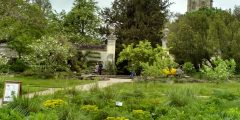01 Arrival
The Cotswolds, day-trip distance from half of England and Wales, contains some of the most gorgeous landscape in Britain
This is a pluperfect hunk of countryside, across south central England, threaded by pretty rivers and studded with gold-clad villages nestling in cosy valleys under dreamy hills. The area takes in more or less of 6 counties, with the biggest share in Gloucestershire and Oxfordshire.
It is the largest of the 38 Areas of Outstanding Natural Beauty in England and Wales. (My pick of the AONBs.) The M4 runs through it for about 12 miles west of Chippenham. The M5 runs close to its western border in Gloucestershire, while the M40 touches it’s north-eastern extremity in Warwickshire.
Direct trains on the railway line from Oxford connect to London, the north and other points of the compass.
And in 2018 the private volunteer-run 15 miles-long railway line to Broadway from the station at Cheltenham Racecourse will open over its entire length. Though not actually in the Cotswolds, the line runs below the scarp.
02 What to see and do
Wool wealth
There’s a rare architectural gem in the heart of many Cotswolds villages and towns, the ‘wool church’. The Cotswold Rich List of the day rolled up their profits from the backs of the local sheep, and bankrolled these impressive churches. St James in Chipping Campden is one of the best.
An even grander monument of Cotswold devotion is Hailes Abbey, the 1246 Cistercian monastery ruined by Henry VIII (now in the care of the National Trust). It’s a serene and peaceful place, on the Cotswold Way. Close by is Toddington railway station, with its film set platform, under signs advertising Fry’s Cocoa and the Unapproachable Norton. You can take a steam train on the preserved Gloucestershire and Warwickshire Railway from here to Cheltenham Race Course.
Wool fuelled a grand house-building spree across the Cotswolds. Many survive and you may visit them. The National Trust’s Snowshill contains a series of intermingling and intimate little walled-off gardens, nooks and hidden bowers designed by the owner Charles Wade in the early 1900s.
The C16th manor house contains his treasure trove of 22,000 objects, from tiny toys to Samurai armour, on display in a magical subdued light. Nearby is Sudeley Castle, a restored Tudor manor. In 1535 Henry VIII planned the dissolution of the monasteries while staying here. The last of his wives, Katherine Parr, is buried in a chapel in the grounds.
Batsford Arboretum
Batsford Arboretum is a short walk away from the Horse and Groom at Bourton on the Hill (featured below). There is a fabulous collection of trees to see, some of them very old, in one of the finest botanical collections in the UK. www.batsarb.co.uk
There are some especially precious new shoots at the arboretum. It’s scarcely credible, but the atomic bomb didn’t kill everything in central Hiroshima in 1945. A few, favoured trees survived. Batsford’s head gardener was sent seeds from Ginkgo and an Ilex Rotunda “survivor trees” in 2015. Some have already germinated in the nursery, and saplings should be in the grounds soon.
Golden Wonder walls.
One ubiquitous feature of the Cotswolds is the dry stone wall, the colour of rich butter. All praise to the Great Wall of China, but there are just as many miles (4000) here, in a complex vertical jigsaw, made from limestone from local quarries.
The golden dry stone wall is found throughout this area of outstanding natural beauty, (40 miles by 20, most of it in Gloucestershire and Oxfordshire). Farmers preferred to enclose their fields with these works of skillfully layered limestone (no cement) than to plant hedges, like emperors paving palaces in gold because they had so much of it.
With changes in farming – the walls are not so necessary to contain sheep and cattle – part of the walls’ incidental function now is to serve as an intricate joined-up nature reserve. Within the stones is a botanical bonanza of such small-scale delights as cushion moss, pennywort, stonecrop, polypody and wall rue.
Cotswold Way
The Cotswold Way (from Chipping Campden to Bath) links the star features of this AONB, divided into convenient day-sized bites. It’s a thrilling rollercoaster of a walk, up and over umpteen stone walls aslant steep slopes. Plenty of drop-dead gorgeous views over rolling hills and valleys.
Treasure trove
The exquisite old market town Moreton-in-Marsh is one of my favourite Cotswold places.You don’t even need a car – direct trains run from London and Oxford. We strolled up the Fosse Way, the wide Roman road that javelins through its heart, ticking off the standard Cotswolds town features – pubs of distinction, smart restaurants, a clutch of antiques shops, tea rooms, several good bakers and butchers. Then an unexpected marvel. Cox’s Yard is a treasure chest of reclaimed building material and architectural antiques. We browsed among ancient churches pews and altar fronts, cast iron pub tables, and an elm chopping block on three legs. We found plaques of King Edward I and Queen Eleanor of Aquitaine, and original enamelled Woodbine cigarettes signs. And the gift for the
gardener who has everything, a 200 ft carved limestone aqueduct from France.
Villa de Luxe
Well off the main tourist track, down quiet lanes in a beautiful wooded combe, are the 1,700-year-old remains of one Britain’s largest Roman villas. Arriving at Chedworth (near Yanworth) just before it closed, we had the place almost to ourselves. So easy to imagine the utter luxury of life in what passed for a palace in those days. After 1300 years of peaceful slumber in the undergrowth it was re-discovered in 1864 by a gamekeeper. The National Trust cares for the fine surviving features in this tranquil place among the trees. Some outstanding mosaics rival those in Pompeii itself. Water tinkles from a natural spring that feeds a shrine, and still runs in a 4th-century stone channel. Look for the very large snails, descendants of a species the Romans imported as a delicacy.
The place to stop
Three star locations sit just east of pleasant market town Stow-on-the-Wold. First stop is Adlestrop, the village where Edward Thomas’s train made an unscheduled stop ‘one afternoon of heat’ in 1914, and inspired his eternal poem of rural peace, Adlestrop (the old station sign is in the bus shelter). The second is Daylesford Farm Shop, an outstanding organic outlet (with a café). Expensive, but they keep high standards.
A few miles on, down a rambling Cotswold lane, is Chastleton House. Much as it was when built in 1612 for a wool merchant, Chastleton is one of our most
complete Jacobean houses. On a summer afternoon aflood with sunshine, it epitomised the rural calm Thomas found so long ago.
New railway station
03 A place to stay
Horse & Groom - the 2017 Tour of Britain passed its door
Horse & Groom, Bourton on the Hill
I approached the Horse & Groom at Bourton on the Hill in the Cotswolds, on a dimming autumnal evening, with “child in the toy shop” level of anticipation.
It had just been voted Pub of the Year in The Good Pub Guide 2016. The guide extolled it as “Handsome, Georgian, honey-coloured stone inn”.
It’s one of the joys of touring in Britain, arriving in the half-light at a warm and welcoming country pub for an overnight stay. The guide lists these enduring, traditional pub features – “wooden chairs, settles, cushioned wall and window seats and tables on bare boards, a woodburning stove in a stone fireplace”.
The Horse & Groom met those high hopes, from the good local beer to the home-made flapjacks in our room. (And free wifi, of course, though it hardly merits a mention these days.) The winning feature, however, is the food. Pub fare is now so much better, and more inventive, than anything (most) hostelries offered in the past.
The blackboard in the photo shows the chef’s ideas for the day. You are presented with this tantalising choice the moment you walk through the door. The board is directly ahead of you. The policy of sourcing ingredients locally and responsibly is now commonplace in country pubs and restaurants, but is still worth noting.
As well as locally-raised meat, poultry and dairy products, they serve fish “wherever possible line-caught by small [West Country] day boats to minimize the impact on the marine environment.” Even now too few restaurants give this sustainability message. If you make the point with meat, do the same with fish and shellfish. It’s too slow in becoming mainstream.
The same applied to the choice of good, properly-fashioned (unadulterated, natural ingredients) beer. Again, the explosion in the range of beers has been phenomenal. On our visit they offered “Hook Norton Lion and Wickwar Coopers WPA on hand pump, local Hogan’s farm cider and locally brewed lagers from the Cotswold Brewing Company.”
The pub also served 22 wines by the glass. This gives you the chance to sample different wines without committing to a bottle. And, if this matters to you, you are not so tempted to over-indulge.
Stay or simply call in – the Horse & Groom is a fine example of the recent revival of the independent hostelry, and in my view one of the singular successes of British tourism recently.
The pub is 2.3 miles from Moreton in Marsh, which has a railway station on the line from Oxford and Paddington. That’s a possible walk during daylight, although you might prefer to take a taxi.
04 Nearby
Oxford is one of the most familiar cities in Britain, after London, even for people who have never been there. Its fine wide streets and noble buildings – even its pubs – have been the backdrop for countless TV programmes and films, from Lewis to Harry Potter. The attractions of this day-out or short stay destination include Einstein’s blackboard, a Christopher Wren theatre to one of Britain’s best indoor markets. The wonderful old Ashmolean has re-opened after a complete internal remake, as one of the most impressive museums in the world.

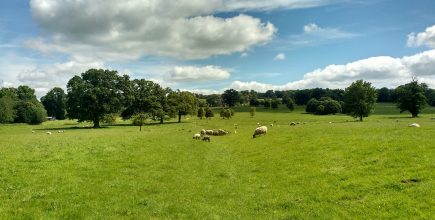
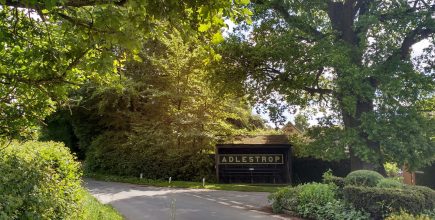
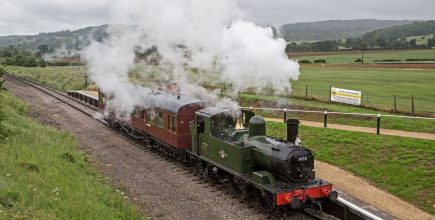
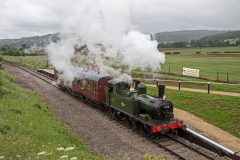 Broadway Station, at the end of the newly reinstated Gloucestershire Warwickshire Steam Railway (GWSR), will open to the public on 30 March 2018. The final stretch of railway line was completed into Broadway in December 2017. An engineering train called there and became the first train to stop at Broadway station since British Railways closed this and other stations on the line, on 7th March 1960. Broadway station itself was demolished in 1963.
Broadway Station, at the end of the newly reinstated Gloucestershire Warwickshire Steam Railway (GWSR), will open to the public on 30 March 2018. The final stretch of railway line was completed into Broadway in December 2017. An engineering train called there and became the first train to stop at Broadway station since British Railways closed this and other stations on the line, on 7th March 1960. Broadway station itself was demolished in 1963.